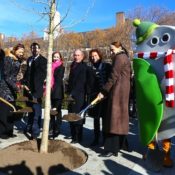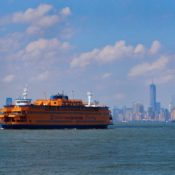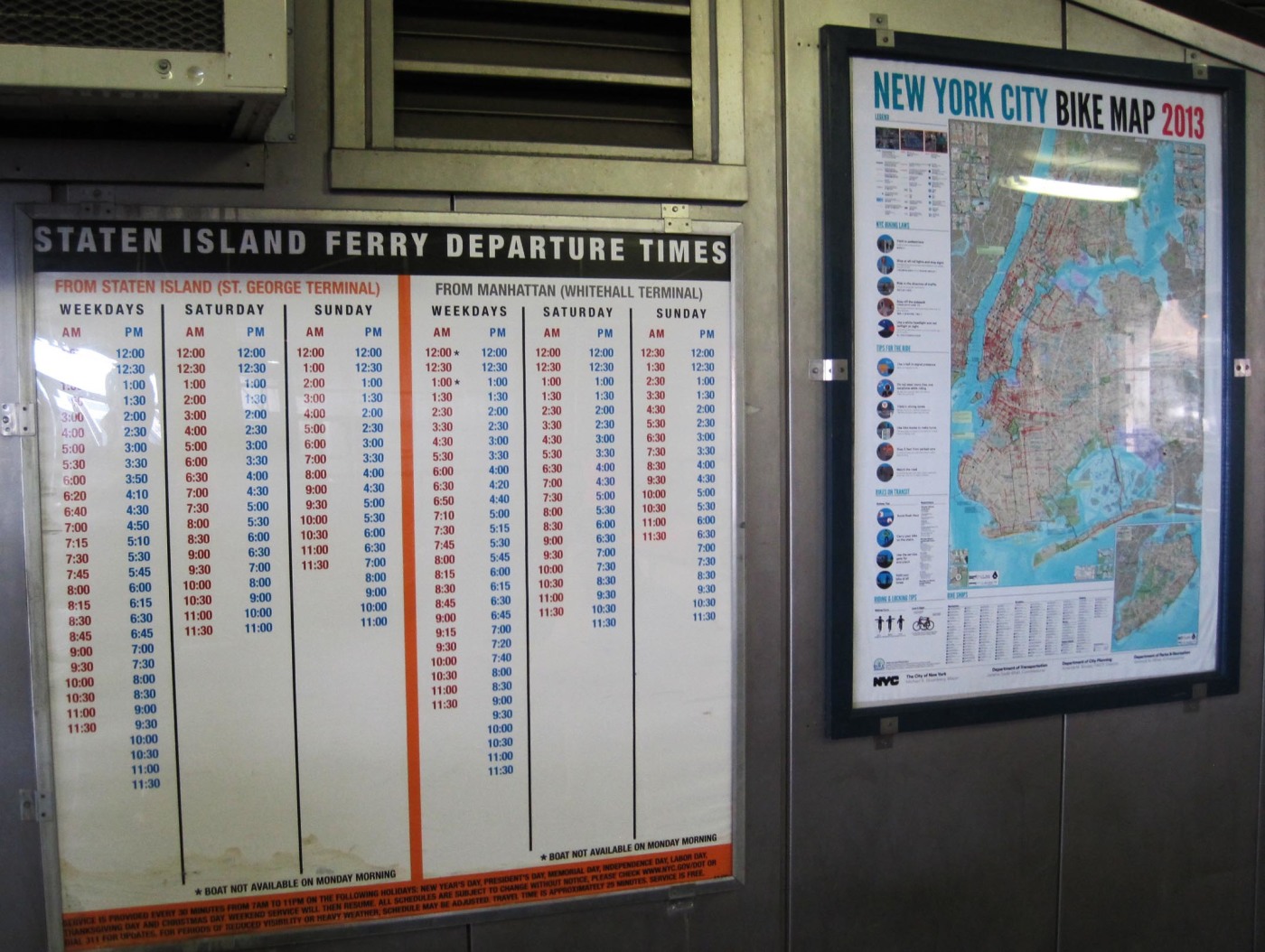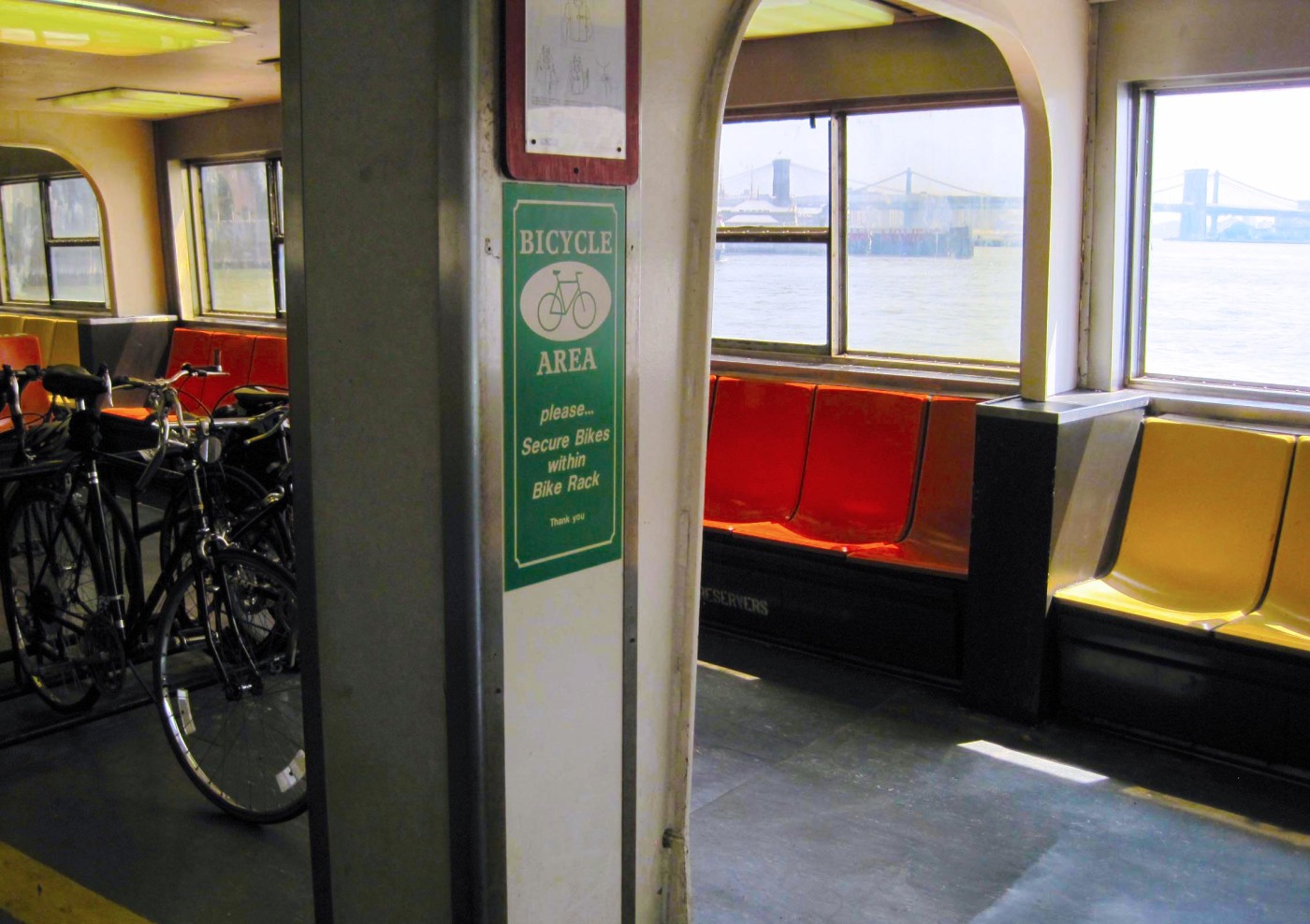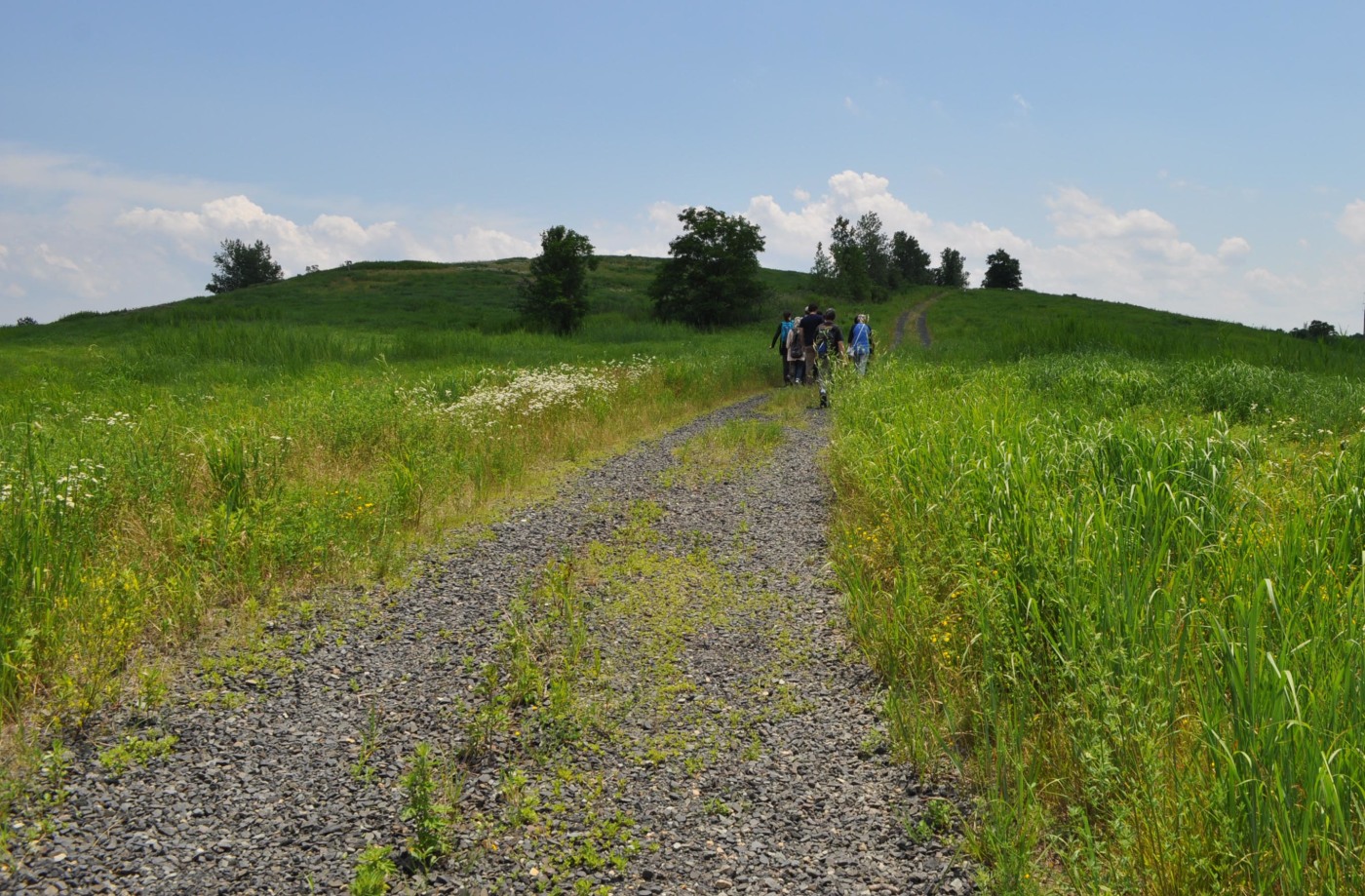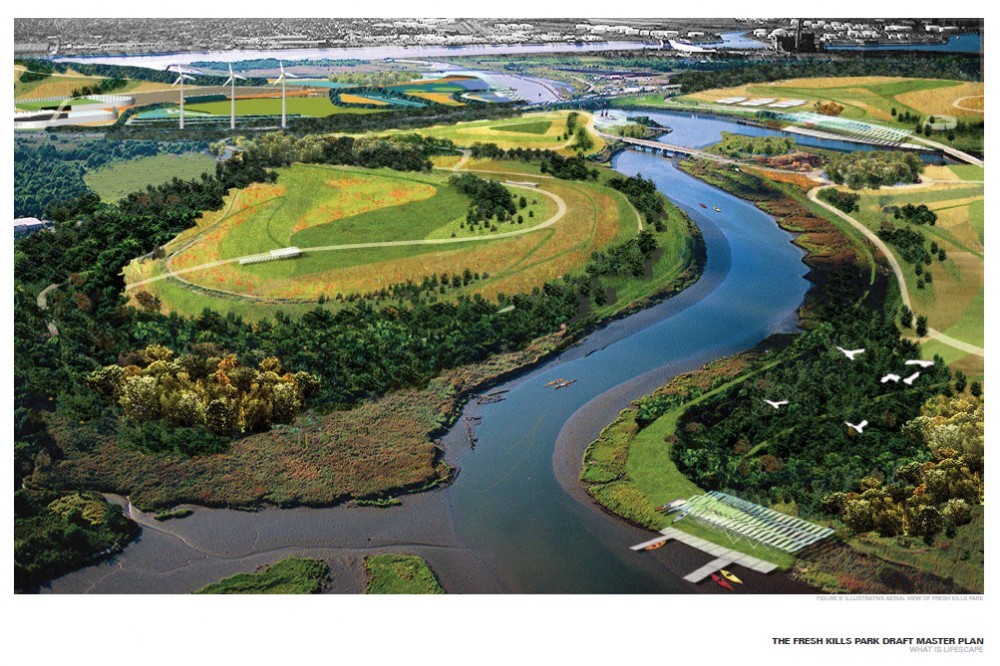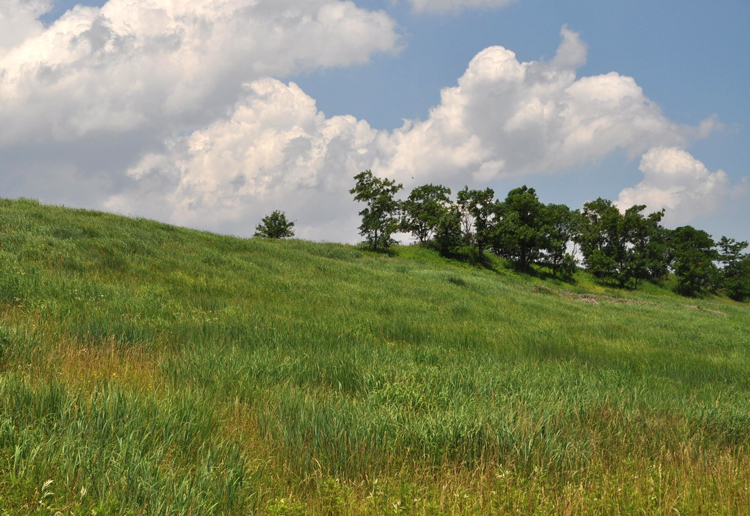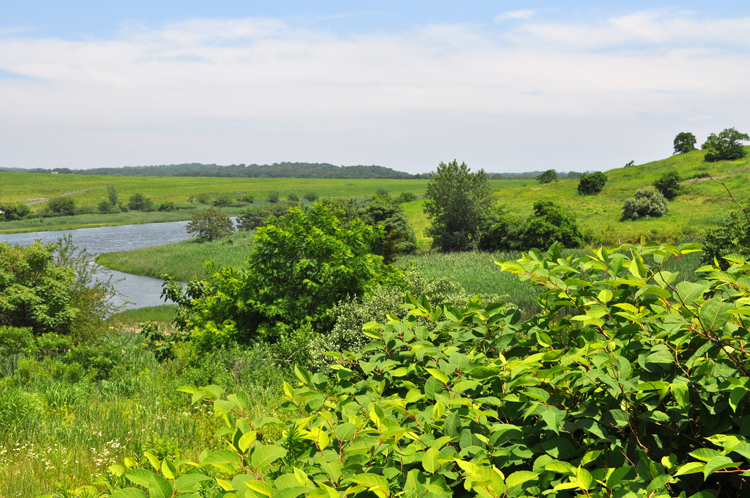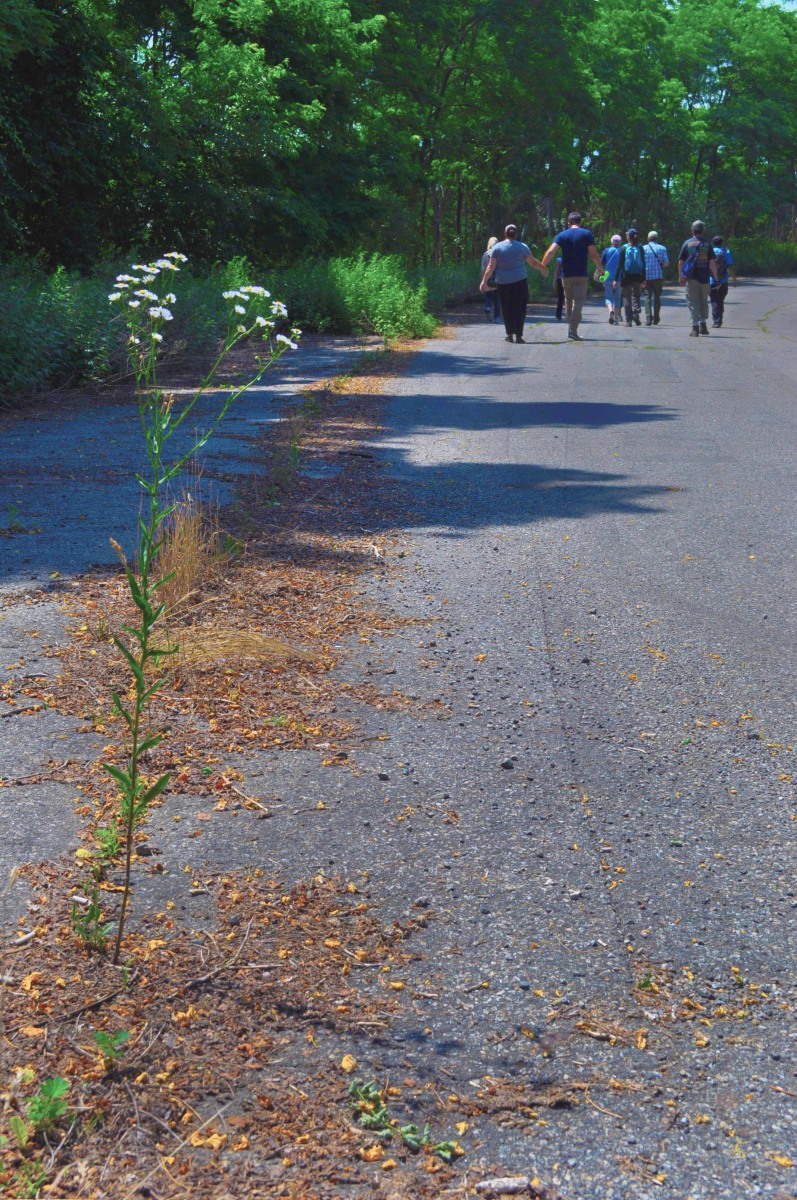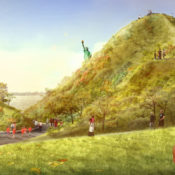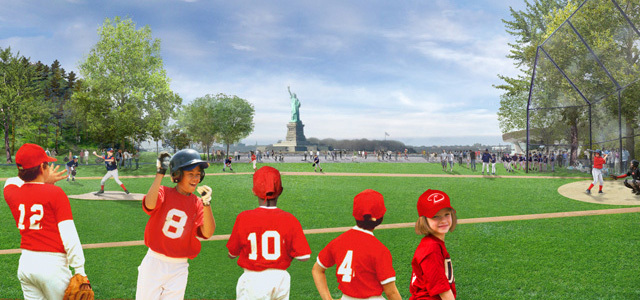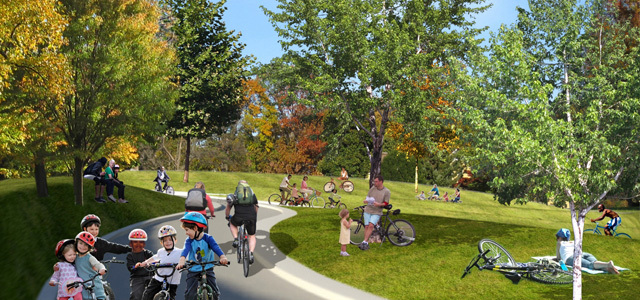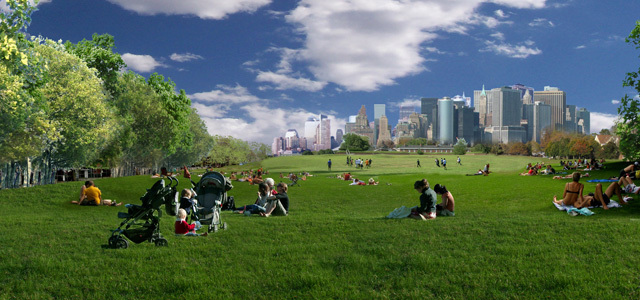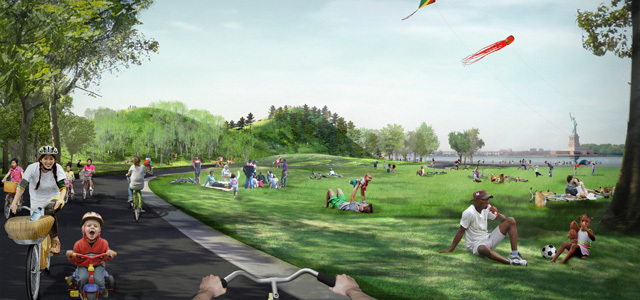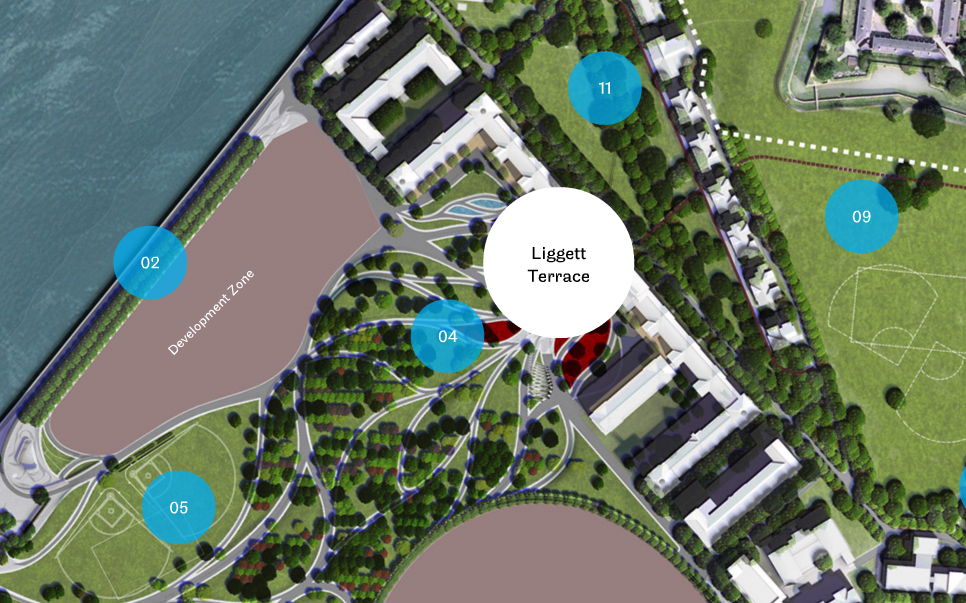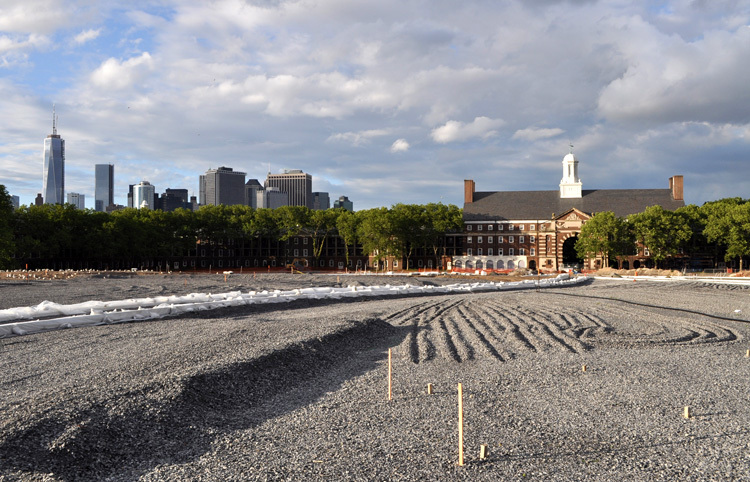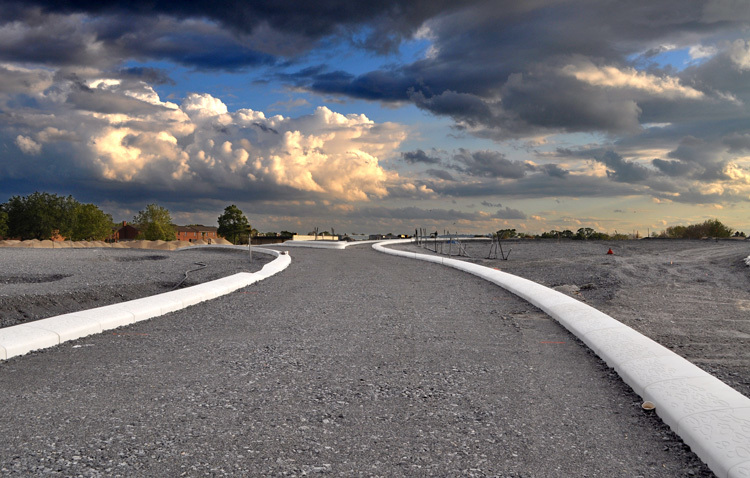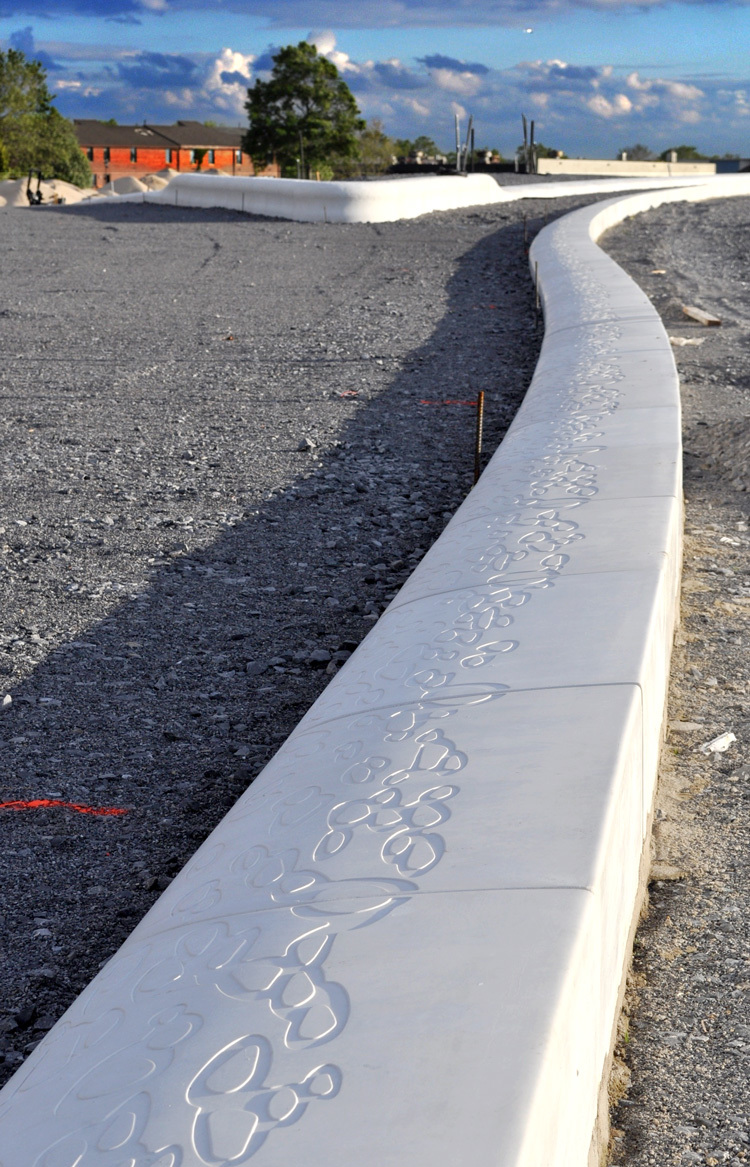Author: Annie Bergelin
A Behind-the-Scenes Sneak Peek at Governors Island’s New Park in NYC
It was a crisp sunny day with clear blue skies in November when I last visited Governors Island. I was cordially invited to participate in the event to commemorate the completion of 30 acres of new park on Governors Island and to plant the 800,000th tree as part of the MillionTreesNYC initiative that Mayor Bloomberg started in 2007. It was a real pleasure to see the newest area of the park, which will be accessible to the public on May 24, 2014.
If you plan to visit to Governors Island in the spring, you will see 2,000 of the MillionTrees newly planted on Governors Island, including Sassafras, Sourwood, Redbud, and Tulip trees. Mayor Michael Bloomberg along with other notable dignitaries affiliated with the park wielded golden shovels full of soil to symbolically help plan a new Gingko tree.
Another exciting new addition to the park are the hammocks! In fact, a whole grove of hammocks! It’s quite possible that the November ceremony may have been the only time that I’ll ever see those hammocks unoccupied. The hammocks are broad enough to fit at least two people and they’re quite welcoming with their bright red hue and generous views over the harbor. In the same way that the outdoor chaise lounges in became so popular at the High Line in NYC and City Deck in Green Bay, Wisconsin, it wouldn’t surprise me if hammocks start making appearances in public parks across the country.
The level of attention that was put into the design of this park is evident in the typography of the Governors Island signage, which was produced specifically for the park. Adriaan Geuze, of West 8, explained to me that they wanted a unique typography for the park that doesn’t exist anywhere else. The design team added a subtle curve to the lettering, which can be most readily seen in the ‘A’, ‘M’, and ‘V’. This elegant detail ties back to the sinuous white concrete walls that line the pathways.
New sculpture installations also enliven the park with a sense of whimsy. The artist Mark Handforth’s ‘Phone in Tree’ sculpture hangs high overhead, prompting everyone to look up and stare at the object, as if waiting for it to emit some important message. The old-fashioned phone receiver is perched in the crook of a denuded tree trunk like a lost and found object forgotten by a giant in the 1990’s.
Meanwhile, the great copper clad Statue of Liberty can be seen in the distance from Governors Island. She can be seen as a backdrop to the dugout of the new baseball fields on the island. During my visit it appeared as if Ms. Liberty was surveying the construction site from the vantage point atop a mound of dirt, making sure everything lives up to her high standards. So far, so good, she seems to say.
Lead image via nycmayorsoffice
All other images photographed by Annie Bergelin
Site Visit: Freshkills Park, New York
Staten Island is probably the most under-appreciated of New York City’s 5 boroughs. Besides riding the Staten Island ferry for a free waterborne tour of the harbor, I have had little reason to visit in the past. But a New York City Parks & Recreation Department private hike of the Freshkills Park reminded me that there are some hidden treasures on that forgotten Island.
Having never explored Staten Island, I decided to add some adventure to my site visit at Freshkills by riding my bike to meet the group. The most direct route from the ferry landing to Schmul Park, the group meeting point, was Victory Boulevard, a distance of about 8.5 miles.
The ferry was bike friendly, providing a designated space equipped with bike racks, bike maps and information, but the ride itself was a much greater challenge. There is no dedicated bike lane on Victory Boulevard and the directness of the route means that the roadway traverses all the hills of Staten Island, making it more adventure than I had prepared for. The true victory was that I made it there in one piece.
But the trek was totally worth it! Freshkills Park is approximately two and a half times the size of Central Park and our group of 12 had the whole place to ourselves. The rolling hills and generous breezes transported my psyche out of the hustle and bustle of the city as we eased into the bucolic afternoon stroll, first up the Little South mound, which is 100’ high, then up Big South mound, which is 135’ high. If I didn’t already know the history of Fresh Kills it would be difficult to distinguish that the mounds are actually huge piles of trash.
Walking over hill and dale we encountered strange pipes popping up out of the ground, pieces of equipment that betray the present-day identity of the place. The pipes are well-heads, which are a necessary part of a landfill because they release the methane gas that is produced by the decaying trash below the surface. The well-heads are the only visible remnants of Freshkills’ former life as a dumping grounds. They have an intriguing industrial aesthetic that reminds visitors to consider the culture that has produced this remarkable terrain, and the admirable work that has gone into its’ reincarnation.
Robert Moses dedicated the site as Fresh Kills Landfill in 1948. There was no concern for the ecological systems that were there and the soggy, muddy land was considered of little use except as a place for putting unwanted things out of sight. By 1955, Fresh Kills was the largest landfill in the world. Finally, on March 22, 2001, Fresh Kills received its last barge of garbage. The landfill was opened again temporarily to manage the debris from the World Trade Center 9/11 attacks.
In 2001, an international design competition brought new hope for the site. The James Corner Field Operations proposal entitled, lifescape, won the competition and set a vision for the new Freshkills park to come.
Courtesy of Department of Parks and Recreation – Draft Master Plan
In its former life, the most common wildlife to be seen at Fresh Kills were seagulls, rats, and cockroaches. These days there is a remarkably biodiverse landscape.
Part of the requisite remediation process for capping a closed landfill is to plant a mixture of native short grasses, but there are also plenty of invasive species present on the site, such as fragmites and mugwort. All of the trees on the site, which includes cottonwoods and black locusts, are volunteer plants that probably came from the unintentional, pro bono work of the numerous birds inhabiting the area.
An inspiring collection of birds and animals has been identified at the site. Parks & Recreation has noted the presence of swallows, killdeer, American goldfinch, redwing blackbirds, red tailed hawks, house wrens and even the occasional bald eagle. We did note see any bald eagles, but we were pretty lucky to see fledgling osprey in a nest that was perched atop a light pole, while the watchful and protective mother circled above, wary of our presence. Some of the animals that have been noted are white tailed deer, muskrat, coyote, and red foxes.
For many years Fresh Kills Landfill produced an offensive odor that wafted over parts of Staten Island. Besides the landfill history there are plenty other preconceived notions and rumors that the site has to overcome. For starters, the name ’fresh kills’ conjures strange images for people who don’t know that the word ’kill’ is Dutch for ‘creek’. In fact, Fresh Kills was named for the idyllic network of streams and wetlands that were originally at the site, which helped to clean the water and buffer storm surges. Also, I can’t say for certain if it’s true, but rumor has it that the area was once used as a mafia ‘dumping’ grounds.
Someone on the hike asked our Parks department leader when the park will be finished and everyone was shocked to learn that the master plan vision would not be realized until 2036. But most people don’t realize that the answer is more complicated than just a projected future date. This park is a work in progress. It is the evolution of a new ecosystem. There will be new plant growth, which will transform the experience of place. It is also interesting to consider that the mounds are expected to settle and shrink up to 10% every 10 years. Despite the Field Operations design of the site, there will continue to be intended and unintended progression of the site, as new life slowly becomes established the park.
Fortunately, my travels home after the hike were facilitated by the generosity of a nice couple who were also on the hike and who happened to have a bike rack on their car. To top it off, they took me to get some of Ralph’s famous ices, which can only be found on Staten Island. I have a whole new appreciation for that 5th borough now.
If you happen to be in the New York City area on Sunday, September 29 there will be a free open house event at Freshkills when the park will be open for everyone to explore the park. There will be activities such as kayaking, walking tours, biking, kite making, food trucks, among other great entertaining things. I highly recommend participating in this great event if you can. But I would also recommend finding an alternative to biking down Victory Boulevard to get there.
A New Landmark for New York City
There are hills rising in New York City harbor! On July 25, Mayor Michael Bloomberg broke ground on the latest phase of construction for the West8 design of Governors Island. A flat area on the southern end of the island, which was once occupied by vacant and derelict buildings, is currently being transformed into a lush, undulating terrain.
A new video presented by West 8 provides a cinematic tour of the future park, capturing the sublime landscape that can be experienced when the hills are opened to the public. The dramatic video montage also demonstrates how the landforms are being constructed, using a simple cartoon-like animation that may appeal to the engineer in all of us.
Not long ago I visited Governors Island to witness the progress of the construction and the new topographies were already beginning to take shape. As a landscape designer, it is exciting to watch the transformation of this high profile public space in New York City. I believe that Governors Island is fit to become a notable new landmark in the city, and the fact that there are already up to 8,000 visitors to the island per day is testament to its’ promising future. Currently, Governors Island is open every Saturday and Sunday through September 29. Portions of the new park areas will be open to the public in Spring 2014, but the Hills won’t be accessible until 2015.
Photos courtesy of West8
Interview with McKenzie Wilhelm, the 2013 Undergraduate Olmsted Scholar
Photo credit: Philip Arnold
In late May, the Landscape Architecture Foundation (LAF) announced McKenzie Wilhelm as the recipient of the 2013 inaugural undergraduate National Olmsted Scholar award. Considering her accomplishments in school at the Ohio State University, her work as an enterprising volunteer, and numerous extracurricular activities it’s not surprising that McKenzie was awarded the honor, but it is no less impressive.
McKenzie was excited to talk to Land8 about her award-winning project proposal. In the following interview she described her research project for the Olmsted Scholarship and shared her thoughts on the landscape architecture profession.
Hi McKenzie. As a National Olmsted Scholar you have been given a great opportunity to pursue independent study and research on a topic that interests you. You proposed to study alternative and sustainable practices for a proposed mining site in Alaska. Can you tell us a little more about the project?
I can’t talk about this project without first mentioning my research partner David Shimmel (Editor’s note: David is the 2013 Graduate University Olmsted Scholar at the Ohio State University), with whom I collaborated on the idea. The project emerged from my interest in large-scale infrastructure and modularity, and David’s interest in the controversial mining practices in Alaska. The Olmsted Award is a huge honor and I am grateful that it will allow me to pursue this research.
Pebble Mine Location Map. Image credit: David Shimmel
The research project is focused on the proposed Pebble Mine, 200 miles southwest of Anchorage, Alaska. The Pebble Limited Partnership, a conglomeration of international mining companies, currently owns the rights to the Pebble Mine claim. The mine sits on one of the most abundant copper and gold deposits in the world. While the Pebble Mine Partnership is currently in the permitting process, some conservation groups and local communities are resisting the proposed mine because of the mine’s ecologically sensitive location. This area provides critical habitat for salmon, a keystone species in the Bristol Bay watershed. David and I position our research as neither advocating for or against the proposed Pebble Mine, but instead take a proactive approach to address the potential risks associated with this mining endeavor.
Pebble Mine Location Map_Detail. Image credit: David Shimmel
What kind of proposal do you envision for the site and why is it important?
This project is about large-scale landscape infrastructural interventions and the importance of ecologically sensitive development. Ultimately, our proposal proactively intervenes within the permitting and design phase before the mine is constructed. There are toxic byproducts produced during the mining process that could contaminate the adjacent rivers, so we are researching systems that could mitigate the toxic runoff. Since these chemicals persist in perpetuity, their containment becomes a critical concern. Because the site is so vast we are researching transitional tools that can adapt to the varying conditions of the terrain, working with the idea of a modular intervention. Modular interventions can be economical to produce and easily repeated throughout the site.
How did you come up with the idea of using modularity as an intervention mechanism?
Modularity is a concept that I studied under Assistant Professor Katherine Bennett during spring studio. It comes from the idea of mass assembly that can be done efficiently. I see the modular approach as a way to take a complex design idea and distill it into a malleable, mass-produced object. Professor Bennett was an important influence on my Olmsted Scholar proposal.
Modular Studio Proposal. Image credit: McKenzie Wilhelm (Assistant Professor Katherine Bennett)
The module that I envision for this project is one that is quickly and easily assembled on site, designed for a contextualized intervention. If we can design a modular system that can address specific, localized issues on the mining site then it may be an acceptable approach for quick intervention. The research concerning exact application for a modular system is ongoing and will be addressed as we continue site research.
What are some of the challenges you anticipate with this project?
The scope of the project presents the biggest challenge. We have divided the project into several research phases where we will be studying the mining process, contextual and site analysis, and design interventions.
Image Credit: David Shimmel
Another challenge is that the site is so remote. We’d like to visit other more accessible precedent mining sites to study the complex interactions between social, environmental and economic realities. Then next summer we will visit the actual site in Alaska. Our time there will be limited so it is important to do thorough research beforehand.
The Olmsted Award also allows me to challenge myself by branching out into new topics that I haven’t explored much in school. Along with the ongoing research with David, this has evolved into my senior thesis project and dedicated studio topic next year. Ultimately, I hope that my work for the Olmsted project can be developed into a publication.
In honor of Frederick Law Olmsted, the namesake of the LAF Olmsted Scholars Program, what FLO project do you admire most?
It may be a cliché, but I love Central Park. It is remarkable how Olmsted was able to envision the importance of open space for New York City. His design is a striking testament supporting the importance of careful planning for our space and resources. Essentially, he had a good idea about what should be there and he made it happen.
And now the Olmsted Award has enabled McKenzie to take her own good idea and make it happen. Congratulations on your award, McKenzie. We wish you good luck for a successful project!
Diana Balmori Recognized as a Leader of Creativity
Dr. Diana Balmori, FASLA, Ph.D, was declared #3 on the list of “100 Most Creative People in Business” in the June issue of Fast Company Magazine. Balmori has advanced innovative design ideas that comingle landscape, architecture, art, and engineering. After glancing through the four prior years of this list, it appears to be only the second time that a landscape architect has been named, after Piet Oudolf in 2009 (there have been more than a few architects on the list in previous years). This is an exciting endorsement of the talent and potential that can be found in the landscape architecture profession. In the Fast Company article Balmori says, “Landscape architecture is an agile tool kit for dealing with the complexity of the city,” which is an astute approach that is easily reflected in her work.
Image: Public Administrative Town, Sejong, South Korea, Courtesy of Balmori Associates and Haeahn Architects and H Associates
In 1990, Diana Balmori founded Balmori Associates, a New York City-based urban and landscape design firm. Balmori Associates are particularly noted for their collaborative work fusing a connection between landscape and architecture. The graceful interface between landscape and architecture can be seen in projects such as the proposed Olympics 2012 Equestrian Venue (in partnership with architect Joel Sanders), and the Public Administrative Town Master Plan for Sejong, South Korea.
Image: Proposed Olympics 2012 Equestrian Venue, Courtesy of Balmori Associates and Joel Sanders Architect.
In 2010 Balmori received a grant from the Graham Foundation for Advanced Studies in the Fine Arts to produce a book, A Landscape Manifesto, which features her design work alongside her theoretical writings about the profession. As the title suggests, the book is a list of 25 principles that are important in landscape design, and each principle is elaborated by Balmori’s design work. Balmori advocates the need for new definitions within the practice to establish a design approach that is sensitive to the cultural and philosophical shift in the traditional understanding of nature. She suggests a new definition of landscape, combining ideas from biology, evolutionary theory, and ecology. The overarching idea is that designers can help establish a more complex and integrated relationship between the city, humans, and nature.
A subsequent book that Balmori co-authored with Joel Sanders, titled Groundwork: Between Landscape and Architecture, builds upon some of the same ideas as the Manifesto, but primarily through the work of other designers.
This isn’t the first time that Balmori has been noted as a leader in the field. She was named 1 of 50 Visionaries Who Are Changing Your World in 2009. The Fast Company recognition is a continuation of Balmori’s clear trajectory as an innovative designer.
By recognizing Balmori’s talents, Fast Company has also acknowledged landscape architecture as a notable business in the creative industry by its own right. Cheers to Diana Balmori for her influential and inspiring work!
All images courtesy of Balmori Associates or as otherwise noted. Diana Profile Image: © Margaret Morton
Site Visit: Governors Island, New York
Walking amid the skyscrapers and crowded sidewalks it is easy to forget that New York City is an aggregation of islands and peninsulas. But a free ferry ride to Governors Island can be a pleasant reminder of the joys to be found in the harbor of this great city. (Above: The view towards New Jersey from Governors Island)
On June 11, I participated in a members-only hard hat tour of the construction that is currently underway on Governors Island. The Van Alen Institute, “an independent nonprofit architectural organization that promotes inquiry into the processes that shape the design of the public realm”, organized the tour in partnership with the Trust for Governors Island. Coincidentally, the tour happened on the same day that Mayor Michael Bloomberg released his new plan to protect New York City from the threat of rising sea levels and storm surges and FEMA released the updated 100-year flood maps, both of which are very relevant to Governors Island. The Trust recorded 13 feet of flooding on Governors Island as a result of Hurricane Sandy.
West 8, a landscape architectural firm whose main office is in Rotterdam, in the Netherlands, is the lead design firm for the project currently being implemented. In 2007, West 8 was one of the five teams that were invited to participate in the design competition for Governors Island and it was their proposal that won the commission to design the new park. The team also included Rogers Marvel Architects, Diller Scofido + Renfro, Quennell Rothschild, and SMWM. Fortunately, the Dutch designers have the sensibility of designing with respect to the relationship between the land and water.
The areas that are currently under construction are:
- Liggett Terrace: a sunny, six acre plaza that features moveable seating, public art, water features and seasonal plantings
- Hammock Grove: 10 acres with 1,500 new trees and hammocks
- Play Lawn: 14 acres including lawn and two turf ball fields for play
- Historic District: 34 acres of respectfully rejuvenated landscapes with new welcoming gateways, flexible spaces for play and new signage, lighting and amenities.
Future phases will include the South Prow, Liberty Terrace, the Hills and the Great Promenade. These areas are pending future funding. More information about each area can be seen at the Governors Island website.
Like other parts of New York City, Governors Island was expanded using landfill, which is where the new project is being built. The island roughly doubled in size when the City used excavated fill from the Lexington Avenue subway line in 1911 to extend the southern end. Atop the original fill, the new mounds for the Liggett Terrace and the Hammock Grove were created with 180,000 cubic yards of gravel and debris from the demolition of vacant buildings on the island. There will be an additional 80,000 cubic yards of engineered soils layered on top of the fill to create the base for planting trees, shrubs, and flowers. West 8 was careful to specify trees with the changing climate in mind. For example, there will not be any plants which grow in the New York City region at their southernmost Hardiness Zone, considering that cooler climate plants will only survive farther north as the region continues to warm for the next century.
Standing atop the highest mound that has been constructed so far it is clear that this will be one of the best panoramic vantage points of the New York City harbor. The Statue of Liberty appears much larger than she normally does from farther points in the city (which doesn’t fully register in photographs) and you can see the skylines of Manhattan, Brooklyn, Staten Island, and New Jersey. The gulls circling overhead are a constant presence on the island and they accentuate the romance of this unique experience.
As a graduate student in the Landscape Architecture department at the Ohio State University I was fortunate to take a seminar this spring featuring Adriaan Geuze and the work of West 8. During one of our seminar meetings Adriaan explained that by designing with the canvas of white you could begin to see the geometries in the organic shapes of the earth and plant materials. He also explained that it is his intention to use white in order to exaggerate the colors of the grasses, which will be planted behind the white retaining walls.
During my visit to Governors Island I could see that the curvilinear retaining walls, which double as benches, also have the effect of highlighting the gentle topography of the mounds. The continuous line reminds me of the Christo and Jeanne-Claude’s Running Fence project, an art installation that uses a similar approach to the landscape. It is a simple gesture that helps focus your eye on the surrounding context and it reveals the subtleties of the terrain. West 8 has added a new poetry to the visitors’ experience of the landscape on Governors Island, which is complimentary to the magnificent views of the surrounding harbor and skylines.
The entire south portion of the island is closed this summer because of the installation of coastal revetment to help protect the island, reconstruction of the seawall and construction on the interior portions of the park. The 30 acres of new public park space will be completed in Fall 2013, but that will be after Governors Island has been closed for the season. The Island and all of the new park space will open to the public for the summer season on Memorial Day weekend 2014, but for me that date can’t come soon enough.
The Trust for Governors Island is leading more hard hat tours of the construction on weekends throughout the summer. The site is also open every Saturday and Sunday through Labor Day (September 29). Information can be found at their website: http://www.govisland.com
What do you think? Leave a comment below…
All photographs by author. Masterplan image via govislandpark.com/areas


